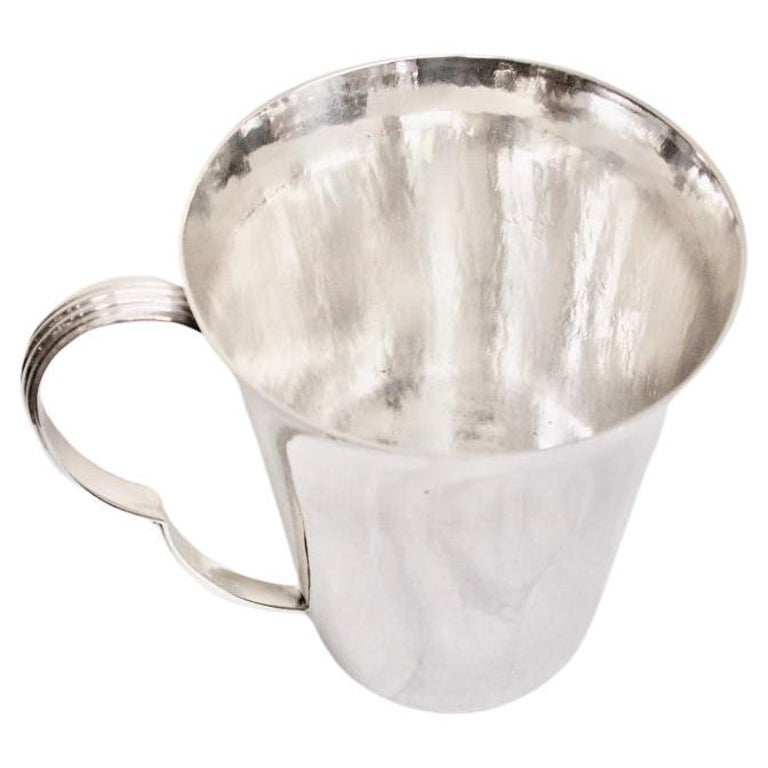Hammered Silver Tankard By H G Murphy Dated 1934 Assayed In London
Hammered Silver Tankard By H G Murphy Dated 1934 Assayed In London
This hammered silver mug is typical of the very unusual style of the above maker, especially the striated ear shaped handle.As always it is made out of a good gauge of silver
Henry George Murphy was a silversmith and jeweller with a career spanning thirty years in which he produced in both the Arts and Crafts and Art Deco styles. Born in Kent in 1884, his initial introduction to his future trade came at the age of ten, when he walked past the hall in which the Arts and Crafts Exhibition Society’s show was held. He was invited in and conversed with Henry Wilson, the Arts and Crafts architect and jeweller, William Morris and Walter Crane. Consequently, he developed a friendship with Wilson and at the age of fifteen joined his workshop as an apprentice. He stayed on as a craftsman and was heavily influenced by Wilson’s work, drawing from Renaissance and Gothic imagery and producing bright polychrome enamel pieces. Due to the similarities in style between the two men during this period, pieces by Murphy are sometimes mistakenly attributed to Wilson.Murphy eventually left in 1910, though he and Wilson continued to work on projects together throughout their careers. With a break for service in WWI, Murphy spent the next decade and a half working in various workshops, including that of Emil Lettré in Berlin, where he worked alongside Bernard Instone, a former colleague from Wilson’s studio, and in a workshop Murphy himself set up in London. During this period he was commissioned to make a jewelled enamel tiara for the Princess Royal, and also made miniature versions of the Crown Jewels for Queen Mary’s Royal Doll’s House, which was exhibited at the Wembley British Empire Exhibition in 1924. The miniatures included a version of the Imperial State Crown just 3cm in height.
In 1928 Murphy set up his own workshop, named the Falcon Studio after his wife Jessie, the ‘jess’ being the leather strap used in falconry, and the falcon emblem was included as part of Murphy’s registered hallmark. Jessie played an important part in the running of the Studio acting as supervisor of the shop and office, and one of Murphy’s trademark motifs - that of the ‘Tree of Life’ - can also be seen as a nod to his wife, the tree representing the genealogy of Christ being known as a ‘Jesse’.
Hammered Silver Tankard By H G Murphy Dated 1934 Assayed In London
This hammered silver mug is typical of the very unusual style of the above maker, especially the striated ear shaped handle.As always it is made out of a good gauge of silver
Henry George Murphy was a silversmith and jeweller with a career spanning thirty years in which he produced in both the Arts and Crafts and Art Deco styles. Born in Kent in 1884, his initial introduction to his future trade came at the age of ten, when he walked past the hall in which the Arts and Crafts Exhibition Society’s show was held. He was invited in and conversed with Henry Wilson, the Arts and Crafts architect and jeweller, William Morris and Walter Crane. Consequently, he developed a friendship with Wilson and at the age of fifteen joined his workshop as an apprentice. He stayed on as a craftsman and was heavily influenced by Wilson’s work, drawing from Renaissance and Gothic imagery and producing bright polychrome enamel pieces. Due to the similarities in style between the two men during this period, pieces by Murphy are sometimes mistakenly attributed to Wilson.Murphy eventually left in 1910, though he and Wilson continued to work on projects together throughout their careers. With a break for service in WWI, Murphy spent the next decade and a half working in various workshops, including that of Emil Lettré in Berlin, where he worked alongside Bernard Instone, a former colleague from Wilson’s studio, and in a workshop Murphy himself set up in London. During this period he was commissioned to make a jewelled enamel tiara for the Princess Royal, and also made miniature versions of the Crown Jewels for Queen Mary’s Royal Doll’s House, which was exhibited at the Wembley British Empire Exhibition in 1924. The miniatures included a version of the Imperial State Crown just 3cm in height.
In 1928 Murphy set up his own workshop, named the Falcon Studio after his wife Jessie, the ‘jess’ being the leather strap used in falconry, and the falcon emblem was included as part of Murphy’s registered hallmark. Jessie played an important part in the running of the Studio acting as supervisor of the shop and office, and one of Murphy’s trademark motifs - that of the ‘Tree of Life’ - can also be seen as a nod to his wife, the tree representing the genealogy of Christ being known as a ‘Jesse’.





